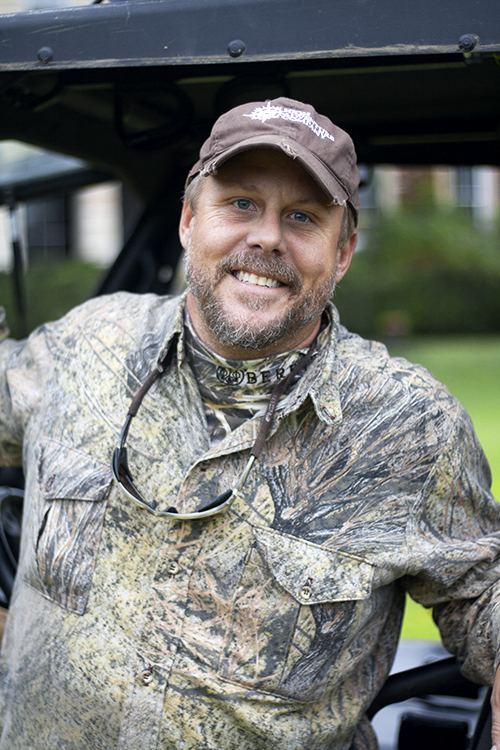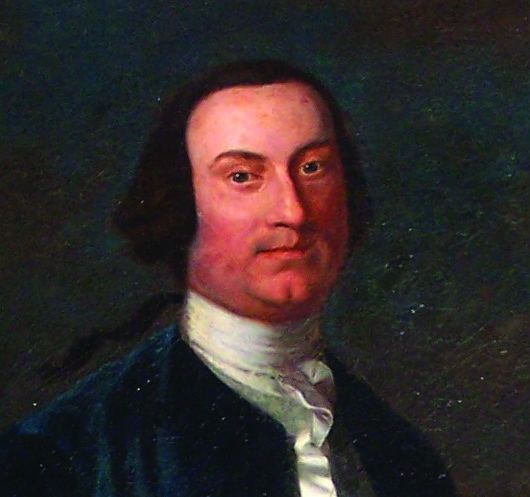Name John II Parents John Tayloe I | Children John Tayloe III | |
 | ||
People also search for John Tayloe I, John Tayloe III, Benjamin Ogle Tayloe | ||
Grandchildren Benjamin Ogle Tayloe | ||
Colonel John Tayloe II (28 May 1721 – 18 April 1779) was among the richest plantation owners in colonial Virginia. He served in public office including the Virginia Governor's Council, also known as the Virginia Council of State. He has been described as a "model Virginia planter, planting tobacco, wheat and corn and raising livestock." A fourth-generation plantation owner from the Tayloe family of entrepreneurs, he took over the management of the Neabsco Iron Works during the 1740s, likely after his father's death in 1747. After he built Mount Airy, the Neo-Palladian Villa overlooking the Rappahannock River, still inhabited by the Tayloe Family today. The Tayloe Family of Richmond County, including John Tayloe II, his father, John Tayloe I, and son, John Tayloe III, exemplified gentry entrepreneurship.
Contents

Early years
Tayloe was born in Richmond County at Old House, located on Rappahannock River, two miles west of Mount Airy, an estate his grandfather had purchased and upon which he built a home. Tayloe was born to John Tayloe I (1688–1747) and Elizabeth Gwynn, daughter of David Gwyn and Katherine Griffin. He had an elder brother, William Tayloe (1716–1726) who died at age 9, a twin sister named Elizabeth, and younger sister named Ann Corbin Tayloe, born 25 August 1723. Tayloe was educated in England.
Career
In 1744, at the age of 23, he was a signer of the Treaty of Lancaster made with the Indians of the Six Nations. After Tayloe's father died in 1747, he inherited a large fortune including 20,000 acres (8,100 ha) and 320 slaves. In 1748 he began building the mansion "Mount Airy," on a hilltop on the north bank of the Rappahannock River in Richmond Co., in the Northern Neck of VA. It was built on the plantation inherited from his father, formerly known as "Tayloe's Quarter," on a different site from that of the Old House. He built the house of stone, which was extraordinary since stone was generally lacking in the Tidewater region of VA and stonecutters were rare. The Tayloe's found a large deposit of hard gray sandstone on the plantation which was quarried for the walls. For window frames and the central pavilions on the entry that frame the front doors and 2nd story windows, John Tayloe got Aquia Creek sandtone, the same nearly white stone used later for the U.S. Capitol and President's House, and in the Octagon. He built the present grand house over a period of 10 years. In 1756, he bought the Occoquan Ironworks company, eventually running it as one business with the Neabsco Ironworks.
In 1758 he completed building "Mount Airy" after 10 years of construction. It introduced a new colonial style, "the first authentic version of what can properly be called colonial Georgian architecture." This style for Virginia colonial estates "proclaimed dominion over its land... a manorial entity intended for a long succession of eldest sons." Mount Airy is the 1st dated example in this country of a broad center hall free of stairs which was used as a sitting room. It was the first house in the colony to use curved walls to enclose the "dependency connectors," or passages to the east and west outbuildings (the west dependency being the kitchen and the east the building in which the family had been living.) It was also among the first to install the "Palladian" window, a central arched opening rising above rectangular side openings. There is a portico in front and one behind. The front portico opens on a beautiful terrace, which is cut from the rolling lawn by a balustrade of red sandstone. Marble steps lead from the lawn to the terrace and from the terrace to the portico. From the portico is an entry to a baronial hall, running entirely through the house. On the right is a small hall from which a stairway runs, and opening upon it and the main hall is the great dining room. On the left there is a large drawing room. Going tranversely from the big hall to the end of the house is another narrower hall in which is another stairway. Across this hall to the back of the house is the library and a sitting room. The 2nd story consists of beautiful, airy bedrooms. From the middle mansion on each side run corridors of glass to two brick houses containing 4 rooms. From the back of the house runs a green sunken bowling alley; one each side are beautiful trees and the gardens. The front lawn contains a collection of hollies, cedars and other evergreens.
In 1759 Tayloe bought what is still identified as the Tayloe House at Williamsburg, VA, on Nicholson Street, for use during sessions of the King's Council, his winter residence. For this newly built residence he paid James Carter, a surgeon and apothecary, 600 pounds, an unusually large amount in those days for a frame house, triple what it cost Carter. The house was restored in 1950. Here and at Mt. Airy he was renowned for his hospitality. At Mt. Airy he had a band, composed of his own servants, whom he had instructed in music for the entertainment of his guests. Lord Dunmore, Royal Governor of VA, was a visitor at Mt. Airy a few years before the breaking out of hostilities in 1776. Mt. Airy became a center for Tayloe activity for many generations, and like Mt. Vernon, was one of the hubs of the exciting world of the early Republic. The Tayloes moved in stellar circles, with the Lees, Jeffersons, Madisons, Adams and Washingtons. Mt. Airy suggests the grand pattern of the nobleman's manor transplanted to American shores.
During the American Revolution, Tayloe supplied the Virginia Navy with "Cannonball, Plant, and Pigg iron". He served in public office as a member of the county court and he sat on the Virginia Council of State. He had approximately 250 slaves. Among his servants were a band of musicians. He was an influential member of the King's Council, under Lord Dunmore, and of the first Republic Council, under Governor Patrick Henry. Tayloe was a member of the House of Burgesses of Virginia 1774.
Tayloe owned more than 20,000 acres (8,100 ha) in the Northern Neck, including land on both sides of the Rappahannock. The Mt. Airy estate was originally acquired by his grandfather, William Taylor (late Tayloe), who bequeathed the property to his son, John Tayloe I, and he to Tayloe II. Tayloe built the mid-Georgian plantation house; construction began in October 1760 and was completed by 1765. It is listed on the National Register of Historic Places as a National Historic Landmark. The property had a 1 mile (1.6 km) long horse racetrack, a deer park, a bowling green, terraced gardens, and a burial ground. The portraits at "Mount Airy," are considered one of the finest private collections in America.
His plantation was supported by interdependent farms (Forkland, Gwinfield, Hopyard, Marshe, Menokin, and Old House) in three counties (Richmond, Essex, and King George). Other plantations were in Stafford County and in southern Maryland. In 1751, Tayloe acquired Menokin Tract, adjacent to Mount Airy. After his daughter Rebecca married Francis Lightfoot Lee, Tayloe built the plantation house of Menokin in 1769 for his son-in-law. In 1765, he was taxed for 8,942 acres (3,619 ha) of land in Loudoun County.
John Tayloe II, and subsequently John Tayloe III and William Henry Tayloe, operated Mount Airy as a successful horse stud farm. John Tayloe II owned Hero, Juniper, Single Peeper, Yorick, Traveller, Nonpareil, and imported Jenny Cameron, Jolly Roger and Childers (by Flying Childers) to Virginia. In December, 1752, at Gloucester, VA, Selima beat Col William Byrd's "Trial", Col Tayloe's "Jenny Cameron" &"Childers" and Col Thornton's "Unnamed"—a sweepstakes, 500 pistoles, four mile heats. This race marks the beginning of the competition between Maryland and Virginia in the annals of Turf.
In 1760 he was the last owner of the famous and influential mare Selima which he acquired after the death of her importer, Col. Benjamin Tasker, Jr. of Annapolis.
In April, 1766, Col Tayloe's "Traveller" won with ease, beating Col Lewis Burwell III of Kingsmill Plantation's "John Dismal" and Mr Francis Whiting's "Janus." In October Col Tayloe's "Hero" won the purse, beating Col William Byrd's "Trial" & "Valiant," and Mr Richard Henry Lee's "Mark Anthony." In November, at Chestertown, Maryland, a purse of 100 pistoles was run for by the two most celebrated horses on the turf, Col Tayloe's Virginia Horse "Yorick" and Sam Galloway of Tulip Hill's Maryland horse "Selim" (by Selima. In May, 1767, Col Tayloe won the "50 Pistoles Purse" with his horse Traveller near Annapolis against: "Trial" Mr Bullen, "Regulus" Mr Calvert, and "Ranger" (Dr. Hamilton). In the spring of 1769, Capt Littleberry Hardyman again won the purse with "Mark Anthony," beating John Tayloe's "Nonpareil" and Nathaniel Wlthoe's "Fanny Murray." In the fall of 1774, at Fredericksburg John Tayloe's "Single Peeper" won the 50 Pound Purse beating Benjamin Grymes' "Miss Spot," Walker Tailaferro's "Valiant," Spotswood's "Fearnaught," Charles Jones' "Regulus," Procter's "Jenny Bottom," Robert Slaughter's "Ariel" and Peter Presley' Thornton's "Ariel."
Personal life
He married Rebecca Plater at the house of Ralph Wormly, Esq., in Middlesex Co., VA, and they had 11 children (two died as babies) so there were 9, all girls except John Tayloe III, their 10th child. His granddaughter, Mary Tayloe Lloyd, married Francis Scott Key. Tayloe was related to Robert Beverley, Landon Carter, Mann Page, and Ralph Wormeley. He supported the Episcopal Church.
In his will, Tayloe made provisions that the Tayloe Charity Fund would be continued as a legacy forever: A charity for the benefit of the poor of a parish given in trust to the minister and vestry; when there ceased to be either, was vested in the overseers of the poor for the parish, by the act of 1805, and they may recover the charity in equity. It met legal challenges in later years.
